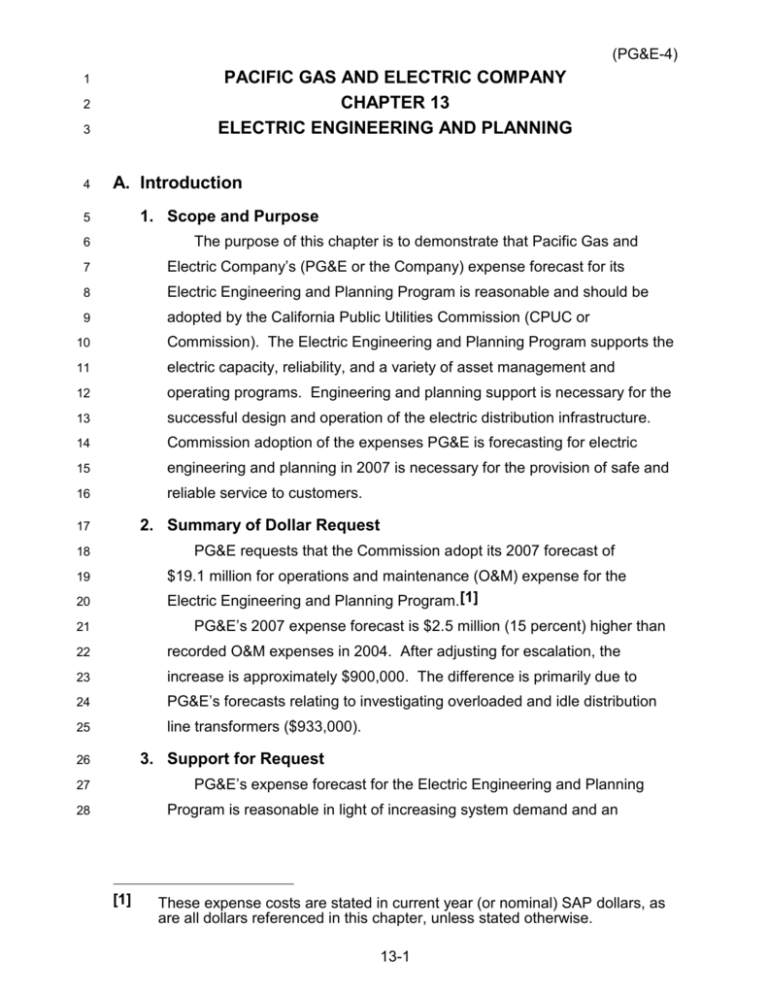A. Introduction - Pacific Gas and Electric Company
advertisement

(PG&E-4) PACIFIC GAS AND ELECTRIC COMPANY CHAPTER 13 ELECTRIC ENGINEERING AND PLANNING 1 2 3 4 A. Introduction 1. Scope and Purpose 5 The purpose of this chapter is to demonstrate that Pacific Gas and 6 7 Electric Company’s (PG&E or the Company) expense forecast for its 8 Electric Engineering and Planning Program is reasonable and should be 9 adopted by the California Public Utilities Commission (CPUC or 10 Commission). The Electric Engineering and Planning Program supports the 11 electric capacity, reliability, and a variety of asset management and 12 operating programs. Engineering and planning support is necessary for the 13 successful design and operation of the electric distribution infrastructure. 14 Commission adoption of the expenses PG&E is forecasting for electric 15 engineering and planning in 2007 is necessary for the provision of safe and 16 reliable service to customers. 2. Summary of Dollar Request 17 PG&E requests that the Commission adopt its 2007 forecast of 18 $19.1 million for operations and maintenance (O&M) expense for the Electric Engineering and Planning Program.[1] 19 20 PG&E’s 2007 expense forecast is $2.5 million (15 percent) higher than 21 22 recorded O&M expenses in 2004. After adjusting for escalation, the 23 increase is approximately $900,000. The difference is primarily due to 24 PG&E’s forecasts relating to investigating overloaded and idle distribution 25 line transformers ($933,000). 3. Support for Request 26 PG&E’s expense forecast for the Electric Engineering and Planning 27 Program is reasonable in light of increasing system demand and an 28 [1] These expense costs are stated in current year (or nominal) SAP dollars, as are all dollars referenced in this chapter, unless stated otherwise. 13-1 (PG&E-4) 1 infrastructure that is both aging and expanding. Additionally, the forecast is 2 reasonable and fully justified because the Company: 3 Efficiently manages the expenses for electric engineering and planning 4 activities through the use of centralized program management; and 5 Maintains expense spending at historic levels, adjusted only for costs for 6 investigating potentially overloaded and idle distribution line 7 transformers. 8 These and other management practices described in this chapter 9 enable PG&E to control expenditures at reasonable levels and effectively 10 11 12 13 14 manage the Electric Engineering and Planning Program. There was no controversy in the 2003 GRC regarding the Company’s expense forecast for the activities this chapter describes. 4. Organization of the Remainder of This Chapter The remainder of this chapter is organized as follows: 15 Program Management Process; 16 Estimating Method; 17 Activities and Costs by Major Work Category (MWC); 18 Translation of Program Expenses to Federal Energy Regulatory 19 20 21 22 Commission (FERC) accounts; and Cost Tables. B. Program Management Process PG&E manages the Electric Engineering and Planning program through a 23 centralized program management approach. An Engineering and Planning 24 manager manages the program. As part of the Engineering and Planning 25 Department, 121 electric planning personnel throughout PG&E’s service territory 26 report through a centralized structure. Their expenses, and expenditures for 27 other work (e.g., investigating secondary voltage complaints), are tracked in 28 MWC FZ. Centralized program management allows for prioritizing engineering 29 and planning work, coordinating technical training for the engineers, using 30 common tools and work procedures, and presenting a smooth integration of 31 associated software and hardware support. 13-2 (PG&E-4) 1 2 C. Estimating Method PG&E’s Electric Engineering and Planning Program expense estimates are 3 based on 2004 expenditure levels adjusted for investigating potentially 4 overloaded distribution line transformers and potentially idle distribution line 5 transformers. 6 In the following sections, PG&E describes the program management 7 process, the numerous major work categories that MWC FZ supports, and 8 descriptions of the types of activities charged to MWC FZ. 9 10 D. Activities and Costs by MWC MWC FZ – Electric Engineering and Planning captures costs for the 11 activities this chapter describes. At the end of this chapter, Table 13-1 displays 12 2000 through 2004 recorded expenditures and estimated 2005 through 2007 13 expenses for MWC FZ. 14 1. Major Work Categories that Electric Engineering and Planning 15 Supports 16 Electric engineering and planning work supports many MWCs that require 17 engineering and planning services. These MWCs include: 18 MWC 06 – Distribution Line and Equipment Capacity; 19 MWC 08 – Mitigate Recurring Outages; 20 MWC 09 – Distribution Automation; 21 MWC 10 – Capital Electric Work at the Request of Others; 22 MWC 16 – Electric Customer Connections; 23 MWC 30 – Rule 20A; 24 MWC 46 – Substation Capacity; 25 MWC 49 – Mainline Protection and Rebuild; 26 MWC 56 – Cable Replacement and Silicon Injection; 27 MWC BA – Electric Distribution Operations; 28 MWC BF – Line Patrols and Inspections; 29 MWC BG – Preventive Maintenance; 30 MWC BH – Corrective Maintenance; 13-3 (PG&E-4) 1 MWC BK – Maintenance of Other Equipment; and 2 MWC GB – Splice/Connector Replacement and Diagnostic Testing. Some examples of the planning processes that are managed by the Electric 3 4 Engineering and Planning program manager that support other MWCs are 5 described in Chapter 6, Underground Asset Management, Chapter 7, Electric 6 Distribution Capacity, and Chapter 8, Electric Distribution Reliability, of this 7 exhibit. The use of common tools and databases ensures that the engineers 8 develop project proposals and alternatives in a consistent manner allowing for 9 10 easier project management and prioritization. Examples of some of the 11 common software programs include C-EDSA (Centralized Electric Distribution 12 System Assets), FDRCAL (Feeder Calculations), OUTAGE (database that 13 captures outage information), LG (Load Growth), and ASPEN to perform circuit 14 modeling, dependability analysis, load studies, and protection studies. The funding in MWC FZ also supports: 15 Investigating secondary voltage complaints that troublemen cannot resolve on 16 the first visit; 17 Supporting operational field work that electric planning personnel initiate, such 18 19 as phase balancing and replacing fuses that are projected to be overloaded; 20 and Investigating potentially overloaded and potentially idle distribution line transformers.[2] 21 22 The 2005 through 2007 estimated expenditures for MWC FZ are based on 23 24 2004 expenditures plus future adjustments for the costs of investigating 25 potentially overloaded distribution line transformers and potentially idle 26 distribution line transformers. Details regarding each of these items follow. 27 2. Investigating Potentially Overloaded and Idle Distribution Line Transformers 28 Distribution line transformers convert primary voltage to service voltage 29 (e.g., 12,000 volts to 120/240 volts). These transformers are pole-mounted, 30 [2] Estimating and mapping personnel typically perform this work. 13-4 (PG&E-4) 1 padmounted, or installed in underground enclosures. They typically range 2 in size from 10 kVa for single-phase transformers to a maximum of 2,500 3 kVa for three-phase padmount units. There are 971,434 distribution line 4 transformers in PG&E’s system. PG&E determines the size (or kVa capacity) of a distribution line 5 6 transformer based on the load the transformer will serve at the time of 7 installation. Once in service, the load that a transformer serves will vary as 8 customers add or remove electric devices and building occupancies change. 9 When customers add too much load without notifying PG&E, a transformer 10 overload can occur. If the overload is high enough, the transformer can fail, 11 causing an outage. 12 PG&E has a transformer load management program (TLM) that 13 estimates the load on a transformer using customer billing information. 14 PG&E refers to the data the TLM provides as the “overloaded transformer 15 report.” While the overloaded transformer report is a useful tool for 16 detecting a transformer overload, the information it provides is not always 17 definitive for the following reasons: 18 A discrepancy between the size of the transformer in the field as compared 19 to the size that is in the Company’s database (e.g., the transformer in 20 the TLM is 25 kVa and indicates overload, but the actual size in the field is 50 kVa);[3] 21 The customers connected to the transformer in the field do not match the 22 23 customers connected to the transformer in the Company’s database 24 (e.g., the TLM program shows 10 customers connected to the 25 transformer, but in reality, only five customers in the field are connected);[4] and 26 Assumptions the TLM program uses in calculating the load on the 27 28 transformer (i.e., load factor, power factor and factors for converting 29 kWh data into demand data) do not match actual load conditions. [3] [4] These discrepancies occur due to inputting errors or not updating the database following a transformer replacement. The TLM is updated when such errors are discovered. As with transformer sizes, PG&E mapping personnel update the TLM when customer assignment errors are discovered. 13-5 (PG&E-4) Because of these issues, the overloaded transformer report only 1 2 provides an indication that a transformer may be overloaded. 3 Consequently, it is incorrect to rely strictly on the information from the 4 overloaded transformer report to create and construct transformer 5 replacement projects. Instead, it is necessary to first investigate the 6 transformer via a field visit to verify the size of the transformer and to 7 validate the number of customers served by the transformer. In some 8 instances it is also necessary to conduct a load test. If the investigation 9 10 reveals that the transformer is not overloaded, MWC FZ absorbs this expense.[5] However, if this effort confirms a transformer overload, PG&E 11 creates a capital project to replace the transformer or perform other 12 mitigating work. The replacement of transformers is charged to MWC 06. 13 The TLM program also provides a list of transformers that do not 14 register any customers (potentially “idle” transformers). Transformers that 15 16 are not serving customer load and are unlikely to serve load in the future are considered permanently abandoned.[6] If the investigation shows that a 17 transformer is permanently abandoned, MWC 10 captures the removal cost. 18 If a transformer is not permanently abandoned, the cost of investigating is 19 charged to MWC FZ. PG&E personnel routinely use the TLM program to check the loading of 20 21 distribution transformers when designing line upgrades and other circuit 22 rearrangements. Many overloaded and idle transformers are identified as a 23 result of these checks. Historically, however, the Company has not 24 dedicated a significant number of resources for the specific purpose of 25 identifying potentially overloaded transformers. The reasons for this are: 26 (1) prior to 2000, the TLM program indicated that approximately 2 percent of 27 the transformers were potentially overloaded during the summer months; (2) 28 transformer outages due to an overload were not perceived as a significant 29 issue; and (3) the process of reviewing transformer loading as part of other 30 distribution estimating work was deemed adequate. [5] [6] Mapping personnel will also update the TLM. The identification of an idle transformer may also indicate that related facilities (e.g., conductors and poles) are also idle. 13-6 (PG&E-4) In 2000, the method for calculating transformer loading was revised.[7] 1 2 The changes resulted in the TLM program indicating that 6 percent of the 3 transformers were potentially overloaded during summer and/or winter 4 months. While this increase concerned PG&E, the energy crisis of 2001 5 occurred and peak demand fell sharply. In fact, transformer related outages 6 decreased between 2000, and 2001-2003. Consequently, the need to 7 proactively investigate these transformers was not high. However, with 8 peak demand again rising (see Chapter 7 of this exhibit for additional 9 information regarding peak demand), PG&E believes it is appropriate to start funding the investigation of potentially overloaded transformers. 10 Identifying potentially idle transformers through the use of the TLM is a 11 12 subset of overall idle facility management. Routine line patrols and 13 inspections may also identify a potentially idle transformer. However, 14 routine patrols and inspections will not identify locations where a meter is 15 installed, but there is no registered usage. In these cases, investigating 16 potentially idle transformers using the TLM report is useful to proactively 17 identify permanently abandoned facilities such as poles, conductors and 18 fuses. The forecast for MWC FZ includes $933,000 in 2007 to investigate 19 20 potentially overloaded and idle transformers. The workpapers for this 21 chapter provide the data supporting this estimate. 22 E. Translation of Program Expenses to FERC Accounts As discussed in Chapter 2 of Exhibit (PG&E-1), PG&E’s program managers 23 24 manage their program costs using the SAP view of cost information, not the 25 FERC account view. Thus, for presentation in this GRC, certain SAP dollars 26 must be translated to FERC dollars. For O&M expenses, the SAP dollars 27 include certain labor-driven adders such as employee benefits and payroll taxes 28 that are charged to separate FERC accounts. These labor-driven adders must 29 be removed from the SAP dollars to present O&M expenses by FERC account. [7] The previous method used billing data from two months only – January (for winter) and August (for summer). The new method uses a rolling 12-month window and the peak month for each season to calculate the transformer loading. There were also adjustments associated with calculating the transformer load factor. 13-7 (PG&E-4) 1 Tables 13-3 and 13-4 show how the SAP expense dollars in the Electric 2 Engineering and Planning program translate to the appropriate FERC accounts. 3 Table 13-3 shows dollars stated in current year dollars (i.e., nominal dollars). 4 Table 13-4 shows dollars stated in base year dollars (i.e., 2004 dollars). The 5 calculations used to deflate the nominal dollars to 2004 dollars (which requires 6 segregating them into their labor and non-labor components) are shown in the 7 workpapers supporting this chapter. The O&M expenses shown by MWC in 8 Table 13-2 are summarized in Exhibit (PG&E-2) Chapter 2, on a base year 9 FERC dollar basis. 10 11 F. Cost Tables The expense forecast for the Electric Engineering and Planning Program is 12 summarized in the following tables: 13 Table 13-2 lists the expense MWC FZ, showing 2004 recorded expenses and 14 the 2005 through 2007 forecasted expenses in SAP dollars stated in current 15 year dollars; 16 Table 13-3 displays the translation of expense MWC FZ to appropriate FERC 17 accounts, showing 2004 recorded expenses and 2005 and 2007 forecasted 18 expenses stated in current year dollars; and 19 Table 13-4 displays the translation of the expense MWC FZ to appropriate 20 FERC accounts, showing 2004 recorded expenses and 2005 and 2007 21 forecasted expenses, stated in 2004 base year dollars. 22 23 24 25 26 TABLE 13-1 PACIFIC GAS AND ELECTRIC COMPANY ELECTRIC ENGINEERING AND PLANNING MWC FZ HISTORICAL AND FORECAST EXPENDITURES ($000) Line No. 1 2 3 4 5 6 7 8 Year Amount 2000 Expenditures 2001 Expenditures 2002 Expenditures 2003 Expenditures 2004 Expenditures 2005 Forecast 2006 Forecast 2007 Forecast $13,340 14,225 15,345 15,793 16,570 17,959 18,635 $19,090 13-8






